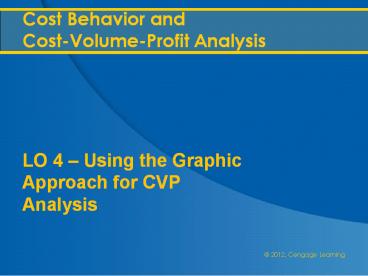Cost Behavior and Cost-Volume-Profit Analysis - PowerPoint PPT Presentation
1 / 21
Title:
Cost Behavior and Cost-Volume-Profit Analysis
Description:
Cost Behavior and Cost-Volume-Profit Analysis LO 4 Using the Graphic Approach for CVP Analysis The primary assumptions of cost-volume-profit analysis are: (1 ... – PowerPoint PPT presentation
Number of Views:157
Avg rating:3.0/5.0
Title: Cost Behavior and Cost-Volume-Profit Analysis
1
Cost Behavior and Cost-Volume-Profit Analysis
LO 4 Using the Graphic Approach for CVP Analysis
2
Cost-Volume-Profit (Break-Even) Chart
LO 4
- A cost-volume-profit chart, sometimes called a
break-even chart, graphically shows sales, costs,
and the related profit or loss for various levels
of units sold.
3
LO 4
Cost-Volume-Profit (Break-Even) Chart
- The cost-volume-profit charts in this section are
based on Exhibit 5, which was constructed using
the following data
(continued)
4
LO 4
Cost-Volume-Profit (Break-Even) Chart
500 450 400 350 300 250 200 150 100 50
Sales and Costs (in thousands)
0
1 2 3 4 5 6 7 8 9 10
Units of Sales (in thousands)
Volume is shown along the horizontal axis.
5
LO 4
Cost-Volume-Profit (Break-Even) Chart
Point A
500 450 400 350 300 250 200 150 100 50
Sales and Costs (in thousands)
1 2 3 4 5 6 7 8 9 10
0
Units of Sales (in thousands)
Point A could have been plotted at any sales
level, because linearity is assumed.
6
LO 4
Cost-Volume-Profit (Break-Even) Chart
Point A
500 450 400 350 300 250 200 150 100 50
Total Revenue
Sales and Costs (in thousands)
1 2 3 4 5 6 7 8 9 10
0
Units of Sales (in thousands)
Beginning at zero on the left corner of the
graph, connect a straight line to the dot (Point
A). This is the total revenue or total sales
line.
7
LO 4
Cost-Volume-Profit (Break-Even) Chart
500 450 400 350 300 250 200 150 100 50
Sales and Costs (in thousands)
Fixed Cost
1 2 3 4 5 6 7 8 9 10
0
Units of Sales (in thousands)
Fixed cost of 100,000 is a horizontal line.
8
LO 4
Cost-Volume-Profit (Break-Even) Chart
500 450 400 350 300 250 200 150 100 50
Sales and Costs (in thousands)
1 2 3 4 5 6 7 8 9 10
0
Units of Sales (in thousands)
A point is marked at 400,000, where 10,000 units
are sold.
(continued)
9
LO 4
Cost-Volume-Profit (Break-Even) Chart
500 450 400 350 300 250 200 150 100 50
Sales and Costs (in thousands)
Total Costs
1 2 3 4 5 6 7 8 9 10
0
Units of Sales (in thousands)
A line is drawn from fixed costs at zero sales
(100,000) to this point. This is the total costs
line.
(continued)
10
LO 4
LO 4
Cost-Volume-Profit (Break-Even) Chart
Cost-Volume-Profit (Break-Even) Chart
500 450 400 350 300 250 200 150 100 50
Sales and Costs (in thousands)
1 2 3 4 5 6 7 8 9 10
0
Units of Sales (in thousands)
The point where the revenue (blue) line and the
total costs (orange) line intersect is the
break-even point.
(continued)
11
LO 4
LO 4
Cost-Volume-Profit (Break-Even) Chart
Cost-Volume-Profit (Break-Even) Chart
500 450 400 350 300 250 200 150 100 50
Sales and Costs (in thousands)
1 2 3 4 5 6 7 8 9 10
0
Units of Sales (in thousands)
Break-even is sales of 5,000 units or 250,000.
12
LO 4
LO 4
Cost-Volume-Profit (Break-Even) Chart
Cost-Volume-Profit (Break-Even) Chart
500 450 400 350 300 250 200 150 100 50
Sales and Costs (in thousands)
Operating Profit Area
1 2 3 4 5 6 7 8 9 10
0
Units of Sales (in thousands)
13
LO 4
LO 4
Cost-Volume-Profit (Break-Even) Chart
Cost-Volume-Profit (Break-Even) Chart
14
LO 4
LO 4
Cost-Volume-Profit (Break-Even) Chart
Cost-Volume-Profit (Break-Even) Chart
A proposal to reduce fixed costs by 20,000 is to
be evaluated. The cost-volume-profit chart in
Exhibit 6 (next page) was designed to assist in
this evaluation. Note that the total costs line
has been drawn from fixed costs at zero sales of
80,000, reducing the break-even point to dollar
sales of 200,000, or 4,000 units.
15
LO 4
LO 4
Cost-Volume-Profit (Break-Even) Chart
Cost-Volume-Profit (Break-Even) Chart
16
Profit-Volume Chart
LO 4
LO 4
- Another graphic approach to cost-volume-profit
analysis, the profit-volume chart, plots only the
difference between total sales and total costs
(or profits). Again, data from Exhibit 5 are
used.
Unit selling price 50 Unit variable cost
30 Unit contribution margin 20 Total fixed
costs 100,000
17
LO 4
LO 4
Profit-Volume Chart
- The maximum operating loss is equal to the fixed
costs of 100,000. Assuming that the maximum unit
sales within the relevant range is 10,000 units,
the maximum operating profit is 100,000, as
shown below.
18
LO 4
LO 4
Profit-Volume Chart
19
LO 4
LO 4
Profit-Volume Chart
Assume that an increase in fixed costs of 20,000
is to be evaluated. The maximum operating profit
would be 80,000, as shown below
Revised Maximum profit
20
LO 4
LO 4
Profit-Volume Chart
21
Assumptions of Cost-Volume-Profit Analysis
LO 4
- The primary assumptions are as follows
- Total sales and total costs can be represented by
straight lines. - Within the relevant range of operating activity,
the efficiency of operations does not change. - Costs can be divided into fixed and variable
components. - The sales mix is constant.
- There is no change in the inventory quantities
during the period.

